2011 Week 8
We had a very busy week even though less excavation was completed. On Wednesday and Thursday, the field school went on its annual field trip to Virginia. The staffs of Colonial Williamsburg, Historic Jamestown and Jamestown Settlement went out of their way to make us feel at home and to share their findings with us. While the main focus of this class is field archaeology, the trip allowed students to see how excavation is done at other sites and to gain a perspective on the interpretation of archaeology to the public in museum settings.
Friday, we were back at work in the area outside the Calvert House fence.
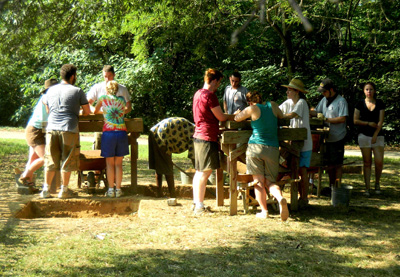
Entire crew working in the area west of the Calvert House fence.
As there were only two units that needed to be completed in this area before we moved back into the yard area for Tidewater Archaeology Weekend, the entire crew worked together to finish them before the weekend. There were a few more 17th-century artifacts in these units than in the others but still not very much. No fences were located but a portion of a large 17th-century post hole was uncovered. This potentially represents another outbuilding but its investigation will have to wait until next year as our field time runs short.
This weekend, we held Tidewater Archaeology Weekend, our major public interpretive event. It is a chance for the public to get their hands dirty and interact with the field school. This year the units to be excavated were in the Calvert House midden and were extremely rich deposits. Archaeologists use the term “midden” to designate a place where occupants of a site threw out their trash on the surface of the ground. The kitchen of the Calvert House was on the west end of the structure and, following the 17th-century rule of trash disposal – find the nearest door or window – trash went west into this area for almost 70 years. As one might expect, food debris, bones and shells, were a main part of this trash.
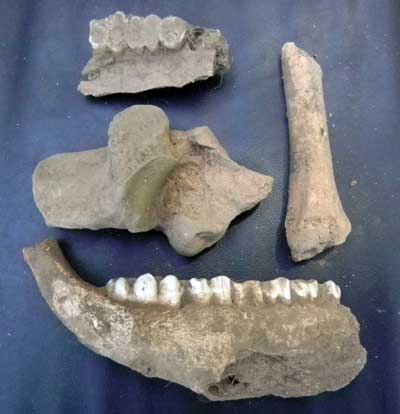
A selection of bones from one of the midden units.
Later, when the material is analyzed, these bones will provide a unique insight on not only what kinds of animals were eaten but how they were butchered and how the meals were prepared. Unfortunately, we chose the hottest weekend of the year for this event with temperatures over 100 degrees on both days.
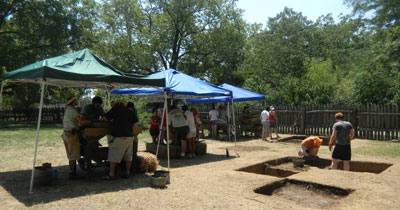
Screening under the tents at Tidewater Archaeology Weekend.
Thanks to the Maintenance Department, we were able to place tents over the screens, which helped tremendously both in the work and the spirits. I was very pleased that, despite the heat, a large number of people came out to participate. They were rewarded with an exceptional group of finds from this rich midden. Various people found such items as a rosary bead, numerous straight pins, large pieces of ceramic, whole pipe bowls, lead shot and a variety of other finds.
A number of finds deserve individual attention but I will only mention a few.
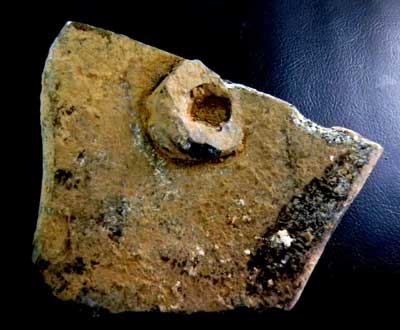
Case bottle fragment with glass pontil scar.
One is a large fragment of a glass bottle base. This was part of a case bottle, what we would today refer to as a gin bottle. The contents were most likely spirits of some kind. In the photo, a glass pontil scar is evident. The bottle was first blown into a square mold. To finish the neck and lip, the glass blower had to insert the formed body into the furnace to heat the glass. He attached the body to a metal rod, called a pontil, with a blob of glass. When the upper part of the bottle was completed, he broke the glass at the bottom, leaving what we see in the photo.
Another unusual object found this weekend was a knife handle.
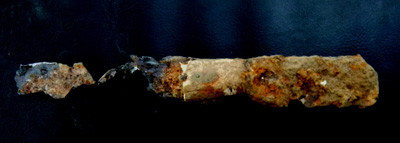
Knife handle with bone inlay.
This was an iron handle which had a bone inlay. Part of the bone is still in place and a rivet is visible in the photo. These two artifacts, the case bottle fragment and the knife handle, reflect the use of the Calvert House as an Ordinary where the Province set rules about costs and accommodations. By law, an Ordinary Keeper had to be ready, 24 hours a day, to provide an ordinary drink and an ordinary meal. St. Mary’s City had a large number of Ordinaries in the 17th Century to accommodate the large crowds that came to town when the Assembly met or the Court was in session.
In any significant deposit from the 17th Century, we can expect to find a large number of tobacco pipe fragments. I mentioned in an earlier entry how important these are to the archaeologist for dating parts of the site. The Calvert House midden not only had a great number of fragments but many large pieces as well.
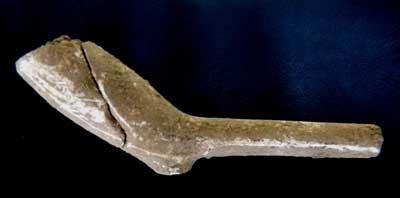
Complete pipe bowl with long stem.
The photo shows a typical kind of pipe found this weekend with a prominent heel at the bottom. Smoking was an important part of the social activities that took place in the Calvert House, as evidence by the thousands of pipe fragments deposited in the midden.
Almost at the end of the weekend, one of the participants found a very interesting pipe fragment.
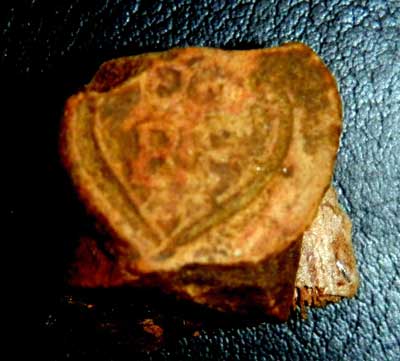
Base of terra cotta pipe with maker’s mark.
This is the heel portion of a molded pipe which has a maker’s mark on it. Maker’s marks on pipes are not unusual however, this is on a locally made, red clay pipe. Most local pipes are hand made and not marked. To have a pipe which is both molded and marked is quite unusual. The mark is heavily worn and hard to see but consists of the initials “R P” in a heart shaped device. Almost at the end of the weekend, one of the participants found a very interesting pipe fragment.
This type of pipe has been found at St. Mary’s City in excavations at other sites, most notably the St. Johns site.

Drawing of R P mark in heart shape from St. John’s site.
This drawing is a cleaned up version of the mark from a pipe found at St. Johns. These pipes could have been made in Maryland, or may have been imported from either Virginia or New England.
Next week is the last week of field school.


